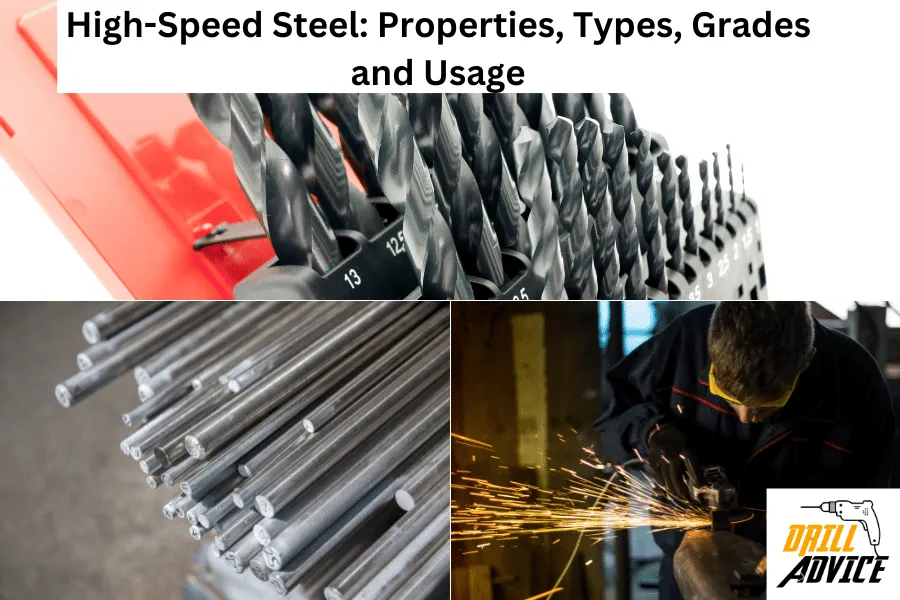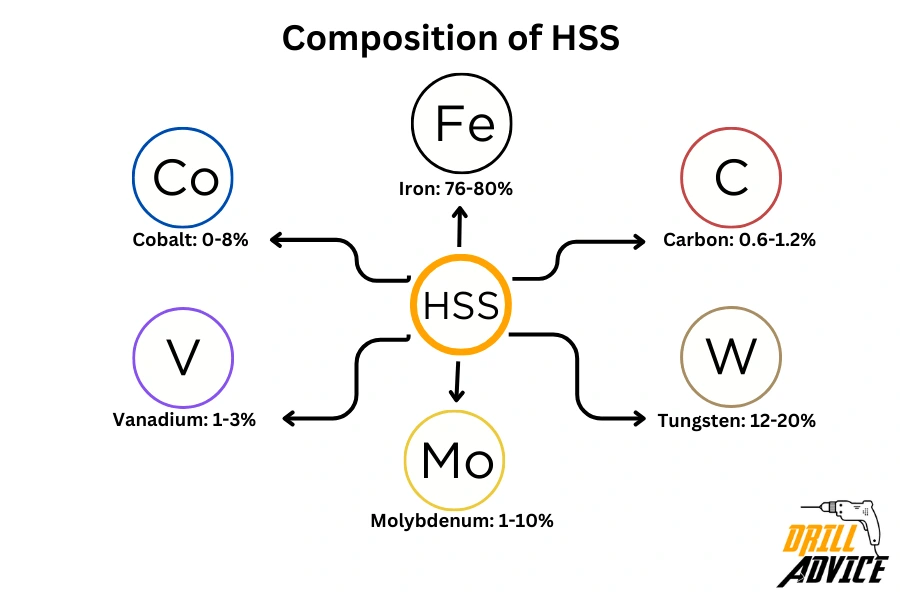
High-Speed Steel (HSS) is a composition metal. High-Speed Steel is made with Iron (Fe) as the base metal and the small amount of adding carbon (C), tungsten (W), molybdenum (Mo), vanadium (V), and cobalt (Co) in different proportions. According to the proportion of HSS, chemical and physical properties is varied.
High-speed steel is not flammable, not toxic and not acidic. Therefore HSS has a higher chemical resistance to the matters. Due to the composition of materials, HSS has a higher physical stability. Therefore HSS is harder and tougher metal.
The composition percentage of HSS will be varied in these ranges such as Iron: 76-80% , Carbon: 0.6-1.2%, Tungsten: 12-20%, Molybdenum: 1-10%, Vanadium: 1-3%, and Cobalt: 0-8%. Due to this variation, HSS has mainly two types: Molebdium high-speed steel and Cobalt high-speed steel. Under this types, there are 7 grades of HSS is available. Those are T1, M1, M2, M7, M35, M42, and M50. These grades are used in different applications and usages.
Mainly HSS is used as the drilling and cutting tools for the power tools. Extra harder metal should be used when you need to cut and drill the HSS. The most suitable and efficient tool for cutting HSS is a carbide tipped saw blade. You can a cobalt drill bit if you need to drill the HSS.
What are the Chemical Properties of High-Speed Steel?
Chemical properties are considered as the characteristics that are observed during a substance’s interaction with other matter, causing it to change its chemical composition. The main chemical properties of a metal are flammability, toxicity, acidity, reactivity and the composition material of the metal.
The High-Speed Steel (HSS) is a composition metal. Therefore chemical properties are varied with the composition material. The composed materials of HSS are iron, carbon, tungsten, molybdenum, chromium, silicon and vanadium.
| Chemical Properties | Values |
|---|---|
| Flammability | No |
| Toxicity | No |
| Acidity | No |
| Iron (Fe) | 75-80% |
| Carbon (C) | 0.5-0.8% |
| Tungsten (W) | 12-18% |
| Molybdenum (Mo) | 0.2-8% |
| Vanadium (V) | 1-2% |
| Chromium (Cr) | 3-4% |
| Cobalt (Co) | 5-8% (in some varieties) |
What are the Physical Properties of High-Speed Steel?
Physical properties are the qualities that can be observed or measured without changing a substance’s chemical identity. These properties play a critical role in determining the applicability of a material. The major physical properties of a metal are color, hardness, density, and melting point, thermal conductivity, and Elastic modulus.
HSS is a composition metal. Therefore HSS are mainly two types and 07 main grades. Each type and grades have specific physical properties. Below is the properties of the most used high-speed steel.
| Physical Properties | Values |
|---|---|
| Density | 8.138 g/cm³ |
| Melting Point | 1430 °C |
| Hardness | 63-65 HRC |
| Thermal Conductivity | 41 W/m·K |
| Magnetic Properties | Ferromagnetic |
| Elastic Modulus | 200-215 GPa |
What are the Composition of High-Speed Steel?

The composition of the High Speed Steel (HSS) is the added small amount of other metal to the base metal. The base metal of the HSS is Iron (Fe). The small amount of added metals are carbon (C), tungsten (W), molybdenum (Mo), vanadium (V), and sometimes cobalt (Co) is added as the composition materials with below percentage of the weight.
- Iron: 76-80%
- Carbon: 0.6-1.2%
- Tungsten: 12-20%
- Molybdenum: 1-10%
- Vanadium: 1-3%
- Cobalt: 0-8%
Iron is added as the alloy’s base, while carbon is added to hardness and wear resistance. Tungsten and molybdenum improve strength and heat resistance, vanadium increases toughness, and cobalt (in some varieties) enhances the heat resistance of the HSS.
Read More About – What to Know About HSS Drill Bits?
How High-Speed Steel Is Made?
Firstly, the metals. HSS is an alloy primarily made up of iron (Fe), with key additions of carbon (C), tungsten (W), molybdenum (Mo), vanadium (V), and occasionally cobalt (Co). These elements collectively contribute to the hardness, heat resistance, and durability of HSS.
This mixture is then heated to melting temperatures of 1420-1450°C, allowing the full amalgamation of the elements. The resultant molten alloy is then cooled very rapidly in a process called quenching.
After quenching, the alloy undergoes a heat treatment process known as tempering. Tempering usually occurs at a much lower temperature, typically in the range of 205°C to 649°C. This process relieves stresses caused by the rapid quenching and makes the steel more durable.
Next, slow cooling takes place. While specific temperatures can vary widely depending on the desired final properties of the steel, it generally starts at the tempering temperature and cools gradually to room temperature.
What are the Types of High-Speed Steel?
The main two types of high-speed steel are Molybdenum High-Speed Steel and Cobalt High-Speed Steel.
Molybdenum High-Speed Steels– Molybdenum High-Speed Steels are categorised as Group M steels. Group M steel has excellent wear resistance, toughness, and the ability to retain hardness at elevated temperatures. Therefore these are used for making cutting tools. Among Group M, M2 grade is the most common. It contains high molybdenum content, offering balanced toughness, wear resistance, and red hardness. M7 is used for heavier construction drills with higher durability. M50 is also used to make heavy-duty using drill bits.
Cobalt High-Speed Steels – Cobalt High-Speed Steels are M35 and M42. M35 has 5% cobalt and M42 has 8% of cobalt. M35 is similar to the M2 behaviours. M42 is harder than M35. Therefore M42 is used for heavy-duty drilling tools.
What are the Grades of High-Speed Steel?

High-Speed Steel is a composition metal. Therefore some metals are mixed with the HSS as a small amount. According to the percentage of the amount, HSS have graded mainly into 7 grades. Those are.
- T1 Grade HSS: T1 is a tungsten-based grade with a high hardness and excellent heat resistance. It’s commonly used to manufacture heavy-duty cutting tools that face a lot of friction and heat.
- M1 Grade HSS: M1 is a molybdenum-based HSS grade. While it doesn’t offer the same heat resistance as T1, it provides excellent toughness and wear resistance, making it suitable for general-purpose tools.
- M2 Grade HSS: M2, another molybdenum variant, balances wear resistance, toughness, and heat resistance beautifully. This makes it a common choice for drill bits and end mills.
- M7 Grade HSS: M7, higher in molybdenum content than M2, boasts enhanced toughness and wear resistance. It’s ideal for producing tools that endure a lot of wear and tear.
- M35 Grade HSS: Known as ‘Cobalt Steel’, M35 contains 5% cobalt, which provides superior heat resistance. It’s often chosen for tools used in high-heat environments.
- M42 Grade HSS: M42, also a cobalt steel, contains 8% cobalt, resulting in phenomenal heat resistance and hardness. It’s typically used for cutting tools in high heat and wear conditions.
- M50 Grade HSS: M50, part of the molybdenum series, offers superior wear resistance and is frequently used in the production of bearings.trations providing varying degrees of hardness, wear resistance, and heat tolerance.
High-Speed Steel Gradings and Composition Materials
| Grade of HSS | C (%) | Mn (%) | Si (%) | Cr (%) | W (%) | Mo (%) | V (%) | Co (%) |
|---|---|---|---|---|---|---|---|---|
| T1 | 0.65-0.80 | 0.10-0.40 | 0.20-0.40 | 3.75-4.50 | 17.25-18.75 | – | 1.00-1.20 | – |
| M1 | 0.78-0.88 | 0.15-0.40 | 0.20-0.45 | 3.50-4.50 | 1.00-1.50 | 8.00-10.00 | 1.75-2.25 | – |
| M2 | 0.78-0.88 | 0.15-0.40 | 0.20-0.45 | 3.75-4.50 | 5.50-6.75 | 4.50-5.50 | 1.75-2.25 | – |
| M7 | 0.78-0.88 | 0.20-0.40 | 0.20-0.45 | 3.75-4.50 | 1.25-1.75 | 8.00-10.00 | 1.75-2.25 | – |
| M35 | 0.93 | 0.3 | 0.3 | 4.1 | 6.4 | 5 | 1.9 | 5 |
| M42 | 1.05-1.15 | 0.15-0.40 | 0.15-0.45 | 3.50-4.50 | 1.15-1.85 | 9.00-10.00 | 1.15-1.85 | 7.75-8.75 |
| M50 | 0.80-0.90 | 0.15-0.35 | 0.20-0.40 | 3.50-4.00 | – | 4.25-4.75 | 0.95-1.35 |
What are the Applications and Usage of HSS Grades?
High-Speed Steel (HSS) is an impressive material with higher durability, resistance to heat, and excellent hardness. Its unique characteristics make it a preferred choice for a variety of applications. Each od HSS grade is used for different applications and usage.
- Grade T1 – M2 HSS is perhaps the most versatile of the HSS grades. It’s used in various cutting tools, including broaches, drills, milling cutters, and reamers.
- Grade M1 – M1 HSS is often used in tools like drills and milling cutters that need a balance between wear resistance and toughness.
- Grade M2 – M2 HSS is perhaps the most versatile of the HSS grades. It’s used in various cutting tools, including broaches, drills, milling cutters, and reamers.
- Grade M7 – M7 HSS is similar to M2 but has higher heat resistance, making it suitable for high-production machine tools.
- Grade M35 – M35 HSS, with its added cobalt, is utilized in conditions requiring high heat resistance. It’s used in manufacturing tools for heavy-duty machining.
- Grade M42 – M42 HSS has the highest cobalt content, making it highly heat-resistant and durable. It’s used for heavy-duty drilling and tapping tools.
- Grade M50 – M50 HSS is commonly used in bearing applications due to its high wear resistance and toughness.
What are the Power Tools Need to Cut and Drill HSS?
HSS can be cut using carbide tipped saw blade and it can be drilled using cobalt drill bit when you are working with them. HSS hardness is 63-65 Rockwell C. But cobalt hardness is 70. Therefore cobalt can be used to cut and drill the HSS.
Carbide-tipped saw blade – Carbide-tipped saw blades are often the go-to when it comes to cutting HSS. Their robust design can endure the hardness of HSS, making them perfect for the job. These blades keep their sharpness for longer, resulting in smooth and accurate cuts.
Cobalt drill bits – Cobalt drill bits are harder, heat resist, and durable drii bit for drilling harder metal such as HSS. M35 and M42 drill bits are extremely suitable drill bits for harder materials.
